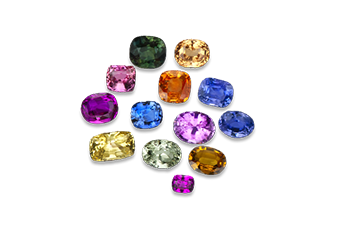SAPPHIRE
Sapphire is a variety of the gem species, corundum. Corundum is aluminum oxide which, when pure, is colorless. If tiny amounts of elements like chromium or iron are present, the resulting gem may be red, blue or virtually any color. Red corundum is considered ruby. All other colors are sapphire. When referring to sapphires other than blue, the color should be stated (i.e. yellow sapphire). Sapphires are found in many countries. India, Myanmar, Sri Lanka, Thailand, Vietnam, Australia, Brazil, Kenya, Madagascar and the United States have all been producers. Sapphires from these sources generally exhibit distinctive colors and qualities. Sri Lankan mines, for example, tend to yield more brilliant, lighter toned gems called Ceylon, Sapphires, in the gem trade. These stones are considered the finest quality sapphires readily available today. Kashmir and Burma stones possess potentially finer color but these sources (India and Myanmar respectively) are not actively producing. Sapphire is a gem that commonly benefits from the application of heat. Ceylon sapphire is no exception.

Image Above: Heat is applied to improve the color, bringing out the hues and tones that are most desirable. Besides sapphire's excellent hardness and toughness, this beautiful gem is sought after, in part, because of its long history. Sri Lankan mines are among the oldest sapphire mines. In ancient times, people thought the Earth rested on a giant sapphire. Sapphire's association with peacefulness and loyalty as well as its status as the September birthstone and 5th & 45th wedding anniversary stone contribute to this gem's popularity as well.

